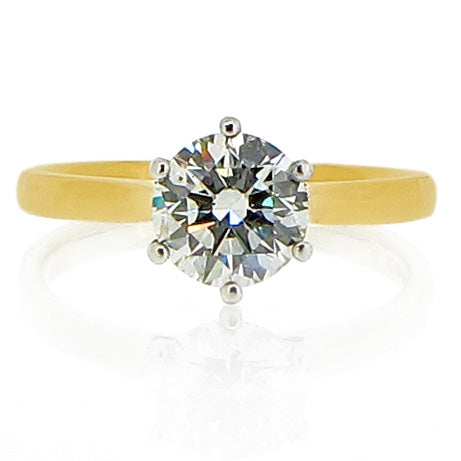Choosing Your Diamond: Cut

Cut can often be one of the more overlooked elements when choosing a diamond, but we regard it as one of the most important things to get right. This is about more than just the shape of the diamond; it regards how the diamond interacts with light and produces the beautiful sparkle and fire that the stone is renowned for. A stone with fine colour and clarity can still appear dull and lifeless if it is poorly cut.
By far the most popular cut for a diamond is the round brilliant, perfected over centuries to maximise the brilliance and fire the stone produces. Generations of expertise have combined to refine the optimum angles and proportions to ensure a perfect balance, and modern cutting techniques allow for elevated levels of precision in today’s diamonds.


The diamond on the left is an old cut stone, faceted before the advent of modern cutting techniques. Looking closely, you can see that the pattern of the facets is a lot less precise and symmetrical, making the shape and the look of the stone less crisp and sharp. The table facet (the flat surface on the top of the stone) is small in comparison to the diamond on the right, which is a modern round brilliant cut. The added precision in the modern stone's cut allows for the best possible brightness and sparkle to be produced. Old cut stones may not have the precision and maximum sparkle of modern diamonds, but each is individual and tells a story about the history of the stone and the diamond cutting process.
Cut is important because it affects the way the diamond interacts with light. If the diamond is cut correctly, light will enter through the crown (the upper part of the stone), reflect from the facets at the bottom and emerge back out of the top as beautiful sparkle. If the cut is too deep or too shallow light will be lost out of the back or sides of the stone and it will not sparkle so much.
Diamonds are also assessed for their symmetry and polish. Symmetry relates to where the facets are cut and their shape and size. For example, it is important that the table facet is centred and lines up with the point or culet at the bottom of the stone: otherwise the diamond can appear lopsided.. Polish relates to the finish of the stone, ensuring that the surfaces are smooth and flat, and that they reflect light effectively.
Most of our diamonds have an independent report from the Gemological Institute of America (GIA) which has grades for cut, polish and symmetry as well as colour and clarity. The grades relating to cut are expressed as Excellent, Very Good, Good, Fair and Poor. Each diamond is assessed for how closely it approaches the specific angles and proportions that have been calculated as producing the best brilliance and fire. An Excellent cut grade means that the diamond is very close to the optimum angles and percentages, with lower grades indicating that the stone is further away from the ideal. The main image at the top of this post shows a diamond with Excellent grades and you can see the high level of symmetry and precise pattern of light clearly in the photograph.




With fancy shapes (those other than the round brilliant), there is no cut grade due to the variations in shape, but the stone will still be assessed for its polish and symmetry. Symmetry is especially important in fancy shapes as this can make a significant difference to the attractiveness of an individual stone. An even and well-proportioned outline is generally regarded as more pleasing to the eye, although personal preference can play a key role. Fancy shape diamonds do produce less brilliance than round brilliants, due to the variation in facet placement required to create the shapes, but a well-cut stone will still have more sparkle that a stone that is poorly cut.
We have a team of highly qualified and experienced gemmologists and diamond graders who can advise you when choosing your diamond; able to answer your questions and reassure you at every stage in the process.


Comments on this post (0)